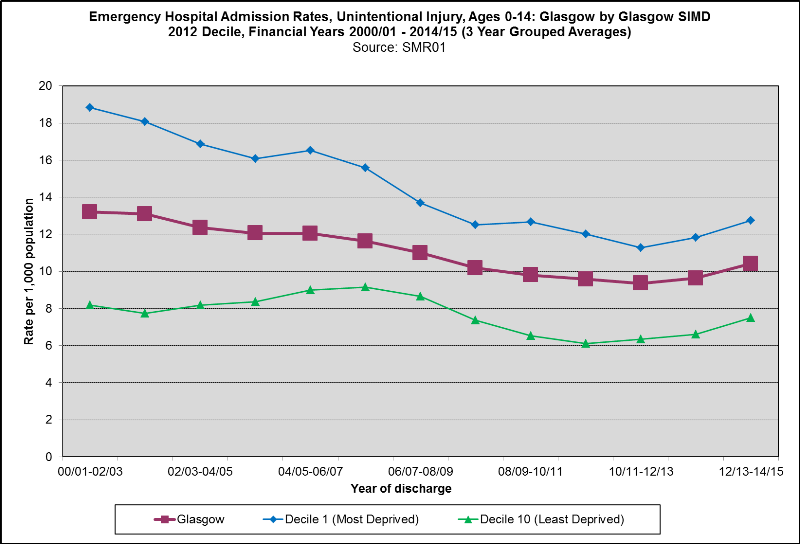Deprivation
Emergency hospital admission rates due to unintentional injury, ages 0-14, by deprivation In the most deprived decile, the emergency admission rate due to an unintentional injury has improved resulting in a relative reduction of 32% from 19 per 1,000 (2000/01-2002/03) to 13 per 1,000 (2012/2013-2014/15).
In the most deprived decile, the emergency admission rate due to an unintentional injury has improved resulting in a relative reduction of 32% from 19 per 1,000 (2000/01-2002/03) to 13 per 1,000 (2012/2013-2014/15).
The rate in the least deprived decile has also improved, resulting in a relative reduction of 8% from 8 per 1,000 (2000/01-2002/03) to 7 per 1,000 (2012/2013-2014/15).
The rate in the most deprived decile has improved relative to Glasgow, dropping from 43% above the Glasgow rate during 2000/01-2002/03 to 22% above during 2012/2013-2014/15.
The rate in the least deprived decile has worsened relative to Glasgow, rising from 62% of the Glasgow rate during 2000/01-2002/03 to 72% of the Glasgow rate during 2012/13-2014/15.
The rate in the most deprived decile has improved relative to the least deprived decile, with the difference in rates dropping from more than double during 2000/01-2002/03 to 70% above during 2012/13-2014/15.
Notes
Scottish Morbidity Records for acute inpatient stays (SMR01) have been used here to calculate the rate of emergency admission of children of 14 years or less to hospital following an unintentional injury in the home (identified as Admission type code 33 = ‘Patient Injury – Home Incident’). The data were based on discharges from completed hospital stays and have been aggregated into rolling groups of three fiscal years to produce annual averages. Both Glasgow specific analyses and the analysis by local authority were undertaken locally.
Figures for Scotland, selected Scottish Cities, and Clyde Valley Councils are provided by Information Services Division (ISD), NHS Scotland. These are a subset of data from the annual ISD report Unintentional Injuries.
Figures for Glasgow by deprivation and by neighbourhood are provided by Information Services, NHSGG&C and are produced using the same methodology as the ISD report (there may be small differences due to using data from live systems at different times)
Further explanation:
When someone is discharged from hospital, the reason for their stay is recorded, and this is coded. If the reason for their admission was the result of an unintentional injury which happened at home, such as a broken leg from falling downstairs or a scald from a hot drink, then this would be included in the figures presented here. Intentional injuries such as assault and child abuse are not included.
When comparing these admission rates, it must be remembered that different hospitals may have different policies for admission, and policies may change over time, so the differences might not all be explained by how many children are injured, but also what thresholds the local hospital departments have for admission. For instance, one hospital might admit every child for observation if they have had a significant bump to their head even if they appear to be well, and another might instead give advice to the parent/carer about things to look out for, and ask them to bring the child back if any of those features develop.
Hospital admissions for injury represent a high level on the “injury pyramid”, with a larger number of injuries treated in A&E departments, minor injuries units or in primary care, and an even larger number never reaching medical attention.
